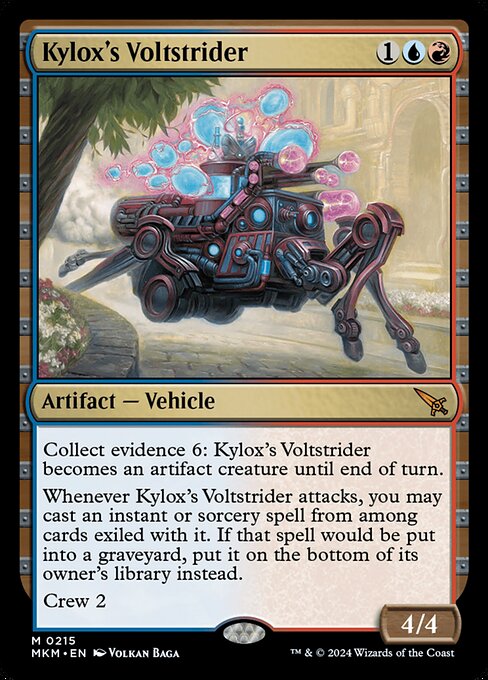
Image courtesy of Scryfall.com
Kylox's Voltstrider and the Izzet Edge in Creature Combat Math
If you’ve ever built a tempo-driven Izzet shell, you know the thrill of weaving faster plays with clever tricks. Kylox's Voltstrider is a prime example of that design philosophy in action. This red-blue artifact vehicle isn’t just a stat-stick; it’s a catalyst for combat math that rewards careful sequencing, the right mix of creatures, and a little bit of deck-building theater. 🧙♂️🔥💎
What the card does, at a glance
- Mana cost: {1}{U}{R} — a true Izzet blend demanding both mana and tempo.
- Type: Artifact — Vehicle, with Crew 2.
- Power/Toughness when it becomes a creature: 4/4.
- Ability: Collect evidence 6 — This Vehicle becomes an artifact creature until end of turn.
- Attack trigger: Whenever this Vehicle attacks, you may cast an instant or sorcery spell from among cards exiled with it. If that spell would be put into a graveyard, put it on the bottom of its owner's library instead.
The combo here is deliciously bite-sized: you figure out how to crew it, swing in with a 4/4 creature, and maximize the window to cast a spell from exile on attack. The bottom-of-library replacement for cards that would hit the graveyard is a small—yet meaningful—card-preservation trick in a format where every draw matters. And yes, the exiled pool is unique—these are cards you’ve set aside with the vehicle, so you’re choosing from a curated, potentially game-changing subset. 🔥
Creature combat math in practice
Mana aside, the key to Kylox’s Voltstrider is how it reshapes the typical creature duel. When you crew it with just two power on your board, you’re turning the 4/4 into a formidable late-game threat for a single attack. The math shifts quickly if your opponent has blockers or removal ready, but that’s when the second half of the card shines: the attack trigger may let you cast a one-off spell from exile—a tempo play that turns a potential trade into a favorable sequence. ⚡
Consider this rough framework for evaluating combat outcomes with Voltstrider on the battlefield:
- Turn timing matters: On your attack step, you’re not just swinging with a 4/4; you’re giving yourself a spell-casting opportunity from exile. A well-timed instant or sorcery can turn a stalemate into a decisive blow, especially when you’ve engineered pressure with multiple threats.
- Blocker math changes with exiled spells: If your foe tries to trade with a 4/4 by splitting damage, you might cast a spell that shuffles the tempo—think removal, bounce, or pump—so your attack survives or clears blockers entirely. That extra line of play matters in long games where card advantage feels like a win condition in disguise. 🎲
- Protecting the package: The bottom-of-library clause helps you avoid losing castable spells to the graveyard, which is particularly relevant if you’ve exiled cards with strong late-game implications. This adds resilience to your combat plan, preserving answers for post-combat or next-turn decisions. 🛡️
- Tempo vs. value: The 4/4 body is not a pure beater; it’s a vehicle that doubles as a creature for one turn of combat. The real payoff is the instants or sorceries you unleash from exile—these spells don’t just chip away at life totals; they can swing the momentum, forcing awkward blocks and awkward post-attack decisions for your opponent. 💥
Deckbuilding notes and strategic instincts
Kylox’s Voltstrider rewards decks that lean into quick, high-impact turns and a toolkit of cheap, efficient spells. The mana cost sits neatly in the three-mana zone, encouraging a splashy start with a pair of free-swinging plays or a tempo-rich draw sequence. A thoughtful approach might include:
- Instants and sorceries that scale with tempo: Look for cheap disruption, card draw, or direct damage that can be cast from exile during your attack step. The payoff is not just removal; it’s accelerating your plan and pressuring the opponent’s life total while keeping your engine going. ✨
- Exile pool curation: Since you’ll be choosing from among cards exiled with the Voltstrider, you want to pair it with spells that are flexible and impactful on the attack trigger. This can be a window to cast a powerful spell you otherwise wouldn’t have drawn. 👁️
- Creature support and protection: While Kylox’s Voltstrider acts as a temporary creature, you’ll still want ways to protect your board or recover if it’s removed. Think cheap permission or bounce to keep the pressure up. 🛡️
Flavor, design, and cultural spark
From a design perspective, the Voltstrider embodies the ironies and playfulness of the Murders at Karlov Manor set: a vehicle that weds investigative flavor—collecting evidence—with explosive spellcraft. The collect evidence dial feels thematic, like your crew is gathering clues while engineering a swift, tactical strike. It’s a creature-combat microcosm where knowledge, timing, and a dash of chaos all collide. The art by Volkan Baǵa captures that moment of ignition—an artifact turned creature, eyes bright with blue and red spark, ready to unleash a carefully selected sorcery at the moment of attack. 🎨
Commander and broader formats
In Commander, Kylox’s Voltstrider shines in builds that lean into spellslinger or artifact-support archetypes. The mixture of colors and abilities invites creative snarls and clever swings, especially when your table appreciates the layered interactions of exiled spells and fleet-footed tempo. In non-rotating formats, it’s a reminder that creature combat math isn’t just about brute force—it’s about the choreography of your threats, saves, and the exact moment you tilt the board toward victory. 🎲
Neon Slim Phone Case for iPhone 16 — Glossy Lexan FinishMore from our network
- https://blog.crypto-articles.xyz/blog/post/fan-appreciation-for-golem-card-art-in-pokemon-tcg/
- https://blog.digital-vault.xyz/blog/post/etsys-best-selling-digital-products-this-year-uncovered/
- https://blog.digital-vault.xyz/blog/post/tracing-bounteous-kirins-enchantment-design-evolution/
- https://crypto-acolytes.xyz/blog/post/why-shining-celebis-typing-fits-pokemon-tcg/
- https://blog.crypto-articles.xyz/blog/post/cautious-view-on-solana-meme-coin-amid-rising-momentum-and-thin-liquidity/